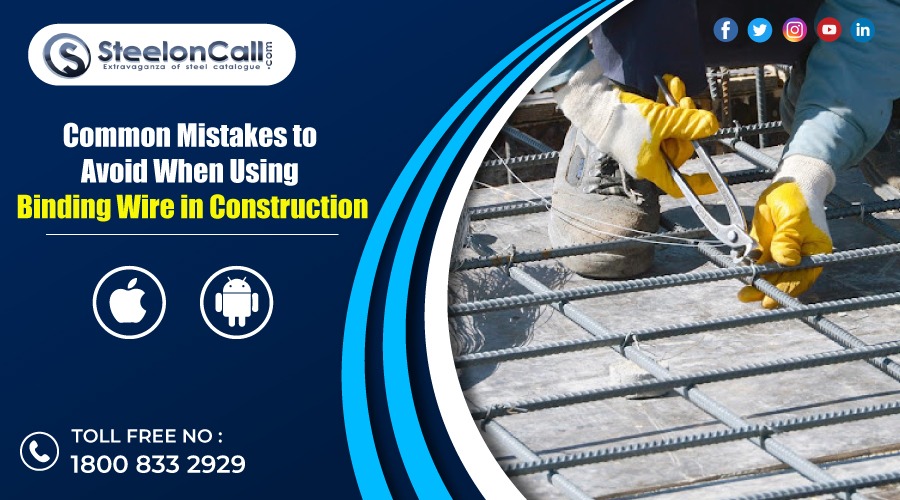Common Mistakes to Avoid When Using Binding Wire in Construction

Binding wire is an indispensable component in construction, used to secure and fasten various structural components together. No matter whether it is being used on residential properties or larger commercial complexes, proper usage of binding wire is paramount to its structural integrity and long-term sustainability. Unfortunately, common mistakes occur with its usage which compromise the safety and quality of construction projects; we will explore them here in detail and offer strategies on how you can avoid these mishaps in this blog post.
1. Selecting the Wrong Binding Wire Type:
Binding wire comes in various materials such as steel, aluminum and copper - each has their own set of properties and uses; selecting the wrong kind could result in several problems such as:
Rust and Corrosion: Placing non-galvanized steel binding wire in areas prone to moisture can result in rust and corrosion over time, weakening its strength and undermining structural stability.
Compatibility: Make sure the binding wire you select is suitable for use with the materials being bound together, such as aluminum with steel components - otherwise this could lead to galvanic corrosion due to dissimilar metals interacting with each other and leading to galvanic corrosion.
Avoidance Tips: Sizing up the environment where the binding wire will be used and choosing an appropriate material (for outdoor applications, galvanized steel may be the ideal choice), before considering its compatibility with materials being bound (to prevent corrosion issues).
2. Incorrect Tension and Tightening:
Tensioning and tightening binding wire correctly are of utmost importance in its success, and mistakes in this area are commonplace. Examples include:
Failing to Apply Enough Tension: Failing to properly tension binding wire can result in loose connections, weakening structural stability of constructions.
Overtightening: Over-tightening the binding wire may result in deformation or damage to the materials it's binding, potentially creating structural weaknesses.
Avoidance Tips: For consistent tensioning of binding wire, pliers designed for tensioning are the optimal tool to use. In accordance with manufacturer recommendations for tension levels to achieve optimal strength without over-tightening, follow their recommendations closely for optimal strength without over-tightening.
3. Inadequate Spacing and Placement:
Spacing and placing of binding wire is key in ensuring the durability of a structure, yet is often neglected as part of its design process. Common mistakes include:
Improper Spacing: Uneven spacing between binding wire loops can lead to uneven stress distribution and create potential weak points within a structure.
Misuse: Placing binding wire too close to materials' edges can result in tears or other forms of damage, jeopardizing their integrity and undermining their structural integrity.
Avoidance Tips: - Utilise templates or guides to maintain consistent spacing between binding wire loops, as well as to ensure it is placed at an ideal distance from materials edges in order to prevent damage to them.
4. Ignoring Safety Precautions:
Safety should always be your number one concern when working with binding wire. Common errors include:
Lack of Personal Protective Equipment (PPE): Failing to wear appropriate PPE such as gloves and eye protection can result in injuries when handling binding wire.
Unsafe Handling: Without adequate training, mishandling binding wire can lead to serious accidents, including cuts or puncture wounds.
Avoidance Tips: when working with binding wire, always wear appropriate PPE to protect yourself from injuries that could arise from its misuse. Train construction workers in how to safely handle binding wire.
5. Inadequate Inspection and Maintenance:
Proper inspection and maintenance of binding wire connections is critical to long-term structural integrity, yet many common errors occur here. Common mishaps include:
Failing to Conduct Regular Inspection: Neglecting to carry out regular wire connection inspections could result in unnoticed issues that compromise the structure's safety, including electrical faults or unconnected wires that don't connect properly with each other.
Neglecting Maintenance: Neglecting maintenance tasks like tightening loose binding wire can result in weak connections and potentially hazardous situations.
Avoidance Tips: - Establish a regular inspection schedule to assess the condition of binding wire connections, performing maintenance as necessary (re-tightening as needed) to maintain strength and stability within your structure.
Conclusion:
Binding wire is an integral component of construction projects, helping ensure its safety and longevity. By avoiding mistakes such as selecting the wrong type of wire, incorrect tensioning, inadequate spacing/placement/spacing/positioning, neglecting safety precautions, insufficient inspection/maintenance procedures and failing inspection and maintenance programs, construction professionals can maximize quality and durability of their structures while creating safer buildings for their communities. Therefore it's crucial that education and training for its proper usage be prioritized to avoid these costly missteps and create safer more reliable buildings that last throughout their lifespans.

